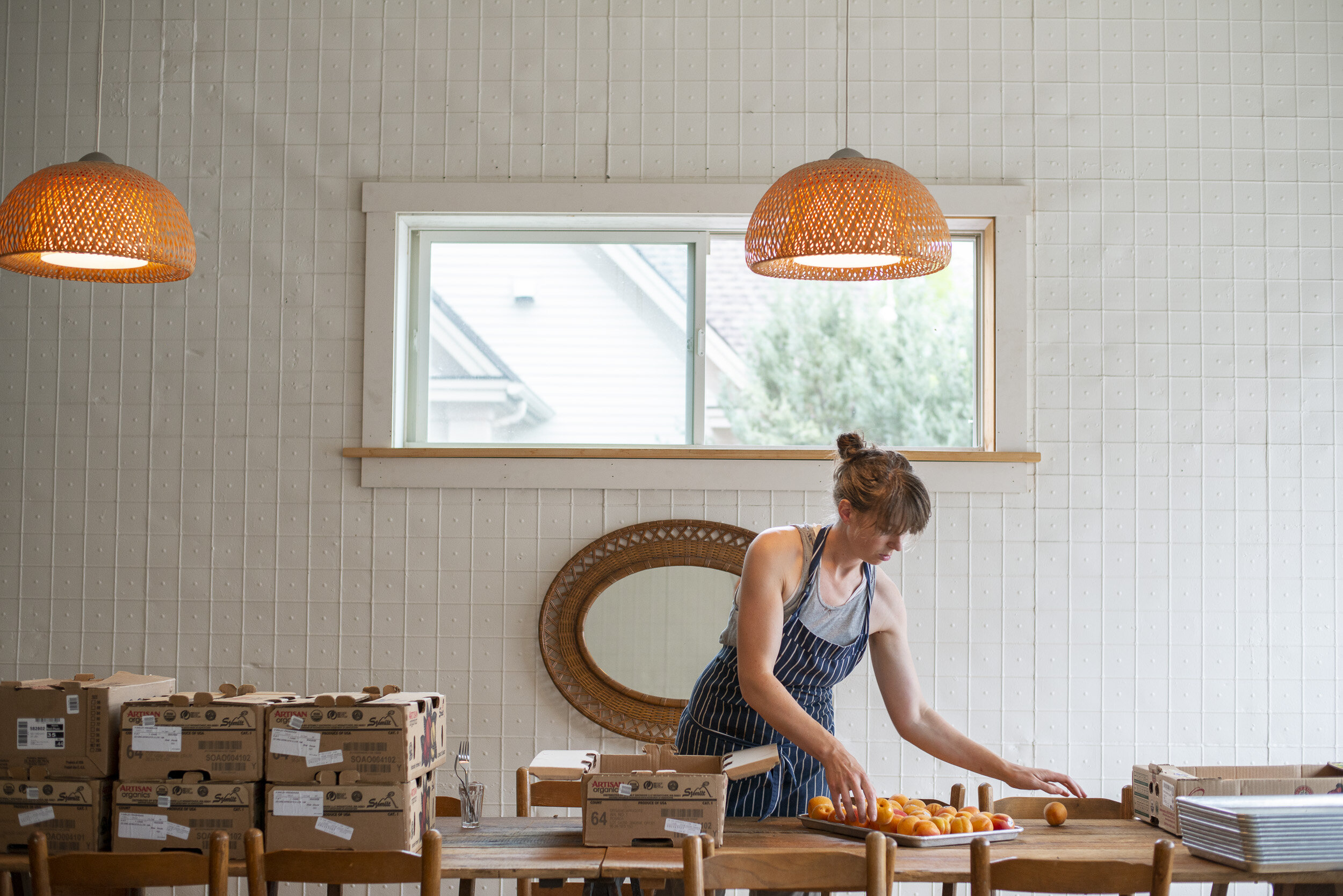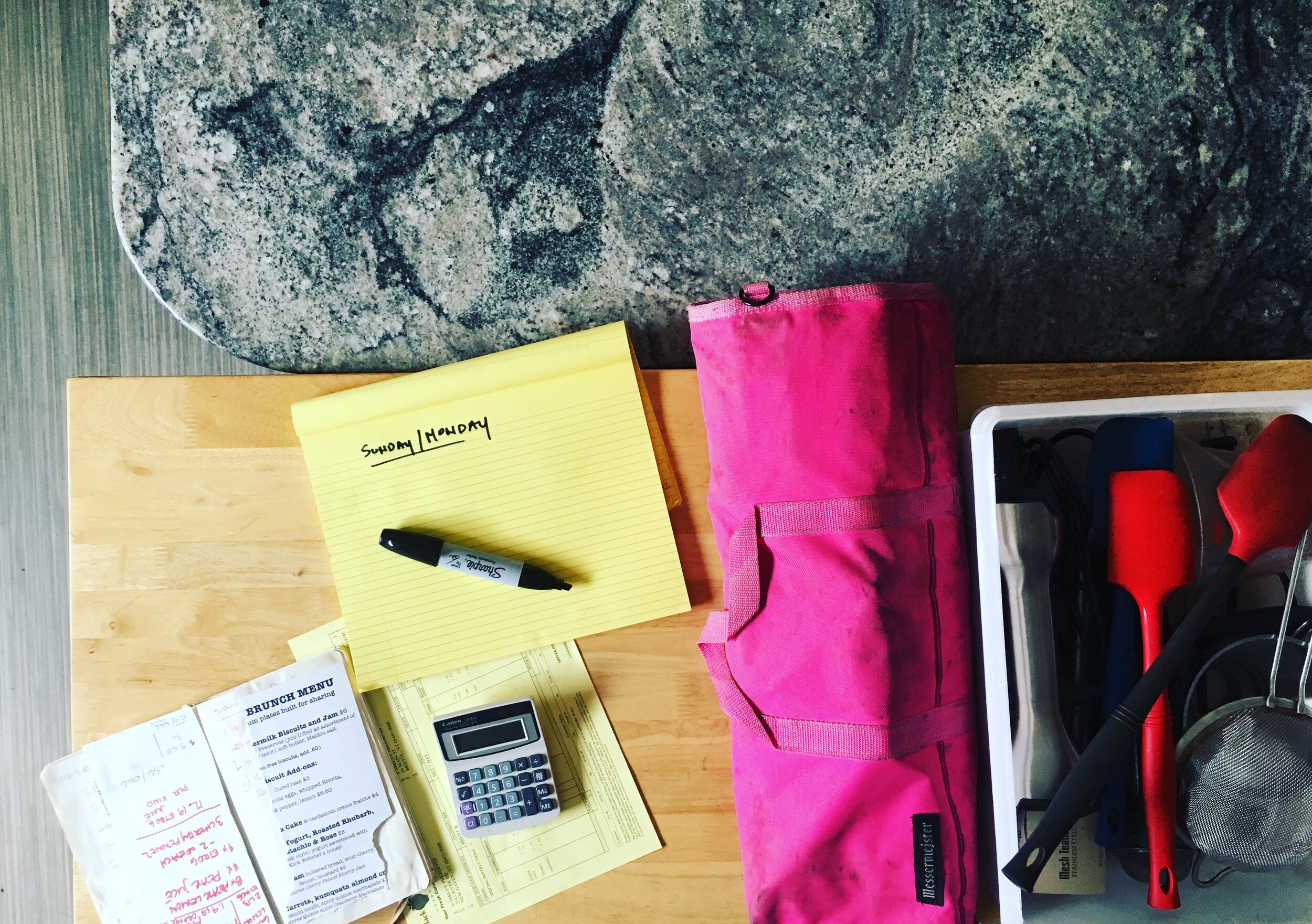Preserves start with fruit, knowing when to order it, who to order it from, learning the eccentricities of each supplier and planning accordingly. The first decision made as fruit comes in the kitchen door is whether it heads into the walk-in cooler or stays out at room temperature to ripen for a day or three. Sometimes there just isn’t any room in the walk-in and then triage starts. What can hang out at room temp for a day while the raspberries get processed into jam? Thank goodness for stone and pome fruits which are less perishable than soft berries.
In the kitchen, fruit is set out on sheet trays, placed on tables, speed racks and when room gets really lean, boxes are repacked with only a single layer of fruit in each box, which are then stacked up into towers of ripening fruit. Part of cooking is sorting and ripening fruit. Trays of apricots or plums set out on Thursday need to be checked and resorted on Friday, Saturday and Sunday. Fruit is processed or chilled in the walk-in while the stragglers on the trays finish ripening. Jam is typically made Sunday-Tuesday but I’m in and out of the kitchen all week moving fruit around and receiving deliveries.
I do a lot of jam math. The calculator slowly gets filled with honey and sticky fruit juices and needs to be replaced each year. I start a kitchen day writing out the flavors on the production docket. The list is dictated by a mix of what’s seasonal (and needs tending right away) and by big wholesale orders, which are mostly cooked to order to maximize shelf life for the shops.
I work in a shared kitchen, which means I unpack and put away my tools every week.
I pull boxes of lids off pallets stored outside the kitchen. I get out my box of spatulas and strainers. I unfurl my knife roll and hone the two knives I use most, a 3 inch paring knife and 10 inch chef’s knife. I compile the sheet trays I put away last week and line them up for sanitizing.
Fruit work is an immense amount of prep. Cases of apples need to be peeled and diced, tomatoes are scored, blanched, peeled and pulverized. Marmalade making--cutting fruit “chips”, those quarter pie pieces of lemons, oranges and limes--constitutes some of the most painstaking kitchen work. Then there’s de-stemming currants and topping and tailing gooseberries.
Every pot of honey jam is cooked with lemon juice. Lemon, lemons and more lemons.
Jam is cooked 4 pots at a time. A giant mix, 4 pots worth of jam, is stirred together in a big bowl. Fruit, honey, and lemon juice all mixed together. Half the recipes are made over the course two or more days. Apricots are cut and then macerate overnight in a honey and lemon bath, which softens the apricots and draws out their juice. This produces a more pleasing texture with a spoonful of finished product yielding a mix of whole fruit pieces and spreadable, juicy goodness.
With the pots on the stove, I fill sheet trays with clean jars, sticking them a 250 degree F oven for 30 minutes. I gather lids and a towel for jarring later. Pots take care of themselves for a while. I mostly ignore them until halfway through the cooking process at which point I’ll start scraping the bottom of the pans with a spatula assessing what’s going on down there. As the jams near finish, I walk between the 4 pots, scraping and scraping until the fruit mixture looks right and sounds right. Yes! We cook by sound too. It’s all about the low, rumbly sounds. That’s a finished pot of jam.
Every jar, 2 oz and 6 oz is filled by hand. The moistened towel swerves as fast as possible around the the curve of the jar rim picking up stray fruit pieces. The lids go on. Twist and twist again.
Once the filled jars finish their final sterilization, they rest overnight with plenty of circulating around the jars. We want the jars to cool quickly and avoid jostling. This quick cooling aids the jar seal, the quality of the product. The less a jar gets bumped and jostled at the start of its life, the more solid the set (aka the texture and way it sets up on a spoon).
The next day back in the kitchen, all the jars are packed into cardboard boxes, inventoried and placed in a car that travels 1 mile east to a warehouse/office space where all the post production work starts.
Jars are unpacked, wiped down with a wet cloth and finished with the a series of labels. Depending on where the jars are headed, wholesale or direct sales (online and farmers market sales), the jars get 2-4 stickers. Side labels, toppers, “best by”, barcodes.
At the warehouse, both ecommerce and wholesale orders get packed up in biodegradable materials. Forty pound boxes of jam destined for specialty shops and groceries around the country are set out for pickup by FedEx at 2:30 PM. Meanwhile, inside, the day’s ecommerce orders stack up at the door, ready for the mail carrier arriving around 3:30 PM.















